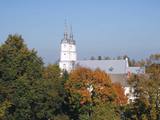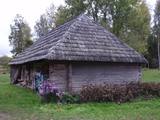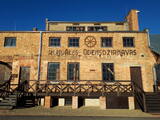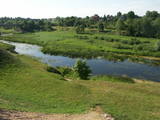| Nr | Nosaukums | Apraksts |
|---|---|---|
|
Driving out of Riga stop at Kemeri National Park for a boardwalk trail through enigmatic bog scenery. Further on the way there is a tasty treat - Pure Chocolate Museum. Ventspils is one of the most affluent towns with excellent infrastructure, well- restored Livonian Order Castle, promenade, arty fountains, manicured parks. Whole town is family oriented but kids particularly enjoy the Blue Flag beach with different swings, climbing and sliding options as well as Kids Town with activity zones for different age groups. A short trip by the narrow-gauge steam engine is a special attraction for kids as well as adults. Water pleasures can be fully enjoyed at indoor or outdoor aqua parks. Go for self-drive excursions in vicinity featuring scenic sea coast, traditional fishing villages where smoked fish can be bought from fishermen, Slitere National Park with beautiful view from its lighthouse, charming Kuldiga with its wooden architecture and waterfall. On the way back to Riga, adults might enjoy stop at the home winery to taste excellent wines made from everything else but grapes. Kids would love a stop at the farmstead to see various farm animals and feed some rabbits. Before Riga make a stop at Jurmala, famous historic sea and spa resort. |
||
|
Kafejnīca "Dzirnas" atrodas Gaigalavas centrā – bijušajā kolhoza administratīvā centra ēkā. Ēdiena gatavošanā izmanto produktus no savas un citām lauku saimniecībām. Latviešu virtuve: Pupu zupa ar grūbām, skābu kāpostu zupa, zirņu zupa, galda biešu lapu zupa, skābeņu zupa, zivju zupa no līņa vai karpas, ceptas ribiņas, cepetis, viltotais zaķis, krāsnī cepta karpa, kaltētas zivis, biezpiena krēms ar ķīseli, cepti āboli ar vaniļas mērci, pītās ruletes, žāvēti augļi un cidoniju sukādes. Īpašais ēdiens: Pupu pankūkas. |
||
|
Atrodas pilsētas centrālajā daļā, Latgales iela'88 b. Mūsdienās redzamās vietā 1685. g. par Krakovas karavadoņa Beļinska līdzekļiem bija uzcelta koka baznīca, ko atjaunoja 1749. g., līdz 1887. g. tā nodega negaisa laikā. Gadu vēlāk sākās divtorņu baznīcas būvniecība (gotikas stils). To iesvētīja 1904. g. Šis ir viens no iespaidīgākajiem Latvijas dievnamiem. Uzmanību ir vērts pievērst vitrāžām ar Sv. Meinarda un Alberta attēliem. Blakus baznīcai atrodas Rēzeknes - Aglonas diecēzes centrs ar bīskapa sēdekli. |
||
|
1753. gadā ar barona Miķeļa Rika gādību uzsāka mūsdienās redzamās baznīcas un klostera celtniecību. Dievnamā (viens no skaistākajiem Latgalē) sākotnēji bija 9 altāri. Tagad baznīcas centrālo altāri grezno astoņas kolonnas ar uzrakstu latīņu valodā Quis ut Deus („Kas ir kā Dievs”). Kreisajā jomā novietots Jēzus Sirds altāris, labajā – Jēzus Kristus ciešanu altāris, ar 18. gs. izgatavotu koka krucifiksu, kam piedēvētas brīnumdarītāja spējas. Par to liecina šeit redzamās pateicības votas. Interesenti var apskatīt Sveču kapelu, sv. Terēzes kapelas, Rožu dārzu, kapelas, kas veltītas dvēselēm šķīstītavā un nedzimušajiem bērniem (pēdējā – baznīcas pagrabā), Krusta kapelu, Fatimas Dievmātes godam veltīto grotu ar Fatimas ganiņu skulptūrām, Rožukroņa dārzu (te bīskapa Meinarda – Latvijas pirmā misionāra skulptūra), draudzes aizbildņa sv. Erceņģeļa Miķeļa skulptūru u.c. Viļānu baznīca un tās apkārtne mūsdienās ir kļuvusi par ievērojamu svētceļojuma galamērķi. Ekskursija iepriekš ir jāpiesaka. + 371 64662413. Klosteris nav pieejams apmeklētājiem. |
||
|
Ciemojoties pie Trīszvaigžņu ordeņa kavalieres, suitu kultūras mantojuma sargātājas, dziesminieces, teicējas Lidijas Jansones, jūs uzzināsiet par suitu vēsturi, tradīcijām un īpašo burdona dziedāšanu, kā arī uzzināsiet, kā senāk mājas apstākļos tapis alus, ko mūsu senči brūvējuši godos un svētkos. |
||
|
Viesmīlīga kafejnīca un konditoreja pašā Siguldas centrā. Piedāvājumā salāti, zupas un citi siltie ēdieni, kā arī smalkmaizītes un kūciņas. |
||
|
Picērija atrodas Kuldīgā netālu no pilsētas vēsturiskā centra. Stender’s picērijas jaukā, mājīgā vidē piedāvā īpašās Stender’s picas, kuras ir pagatavotas ievērojot senās picas cepēju tradīcijas apvienojot ar mūsdienu labākajām atziņām. Bez šaubām neiztikt bez pankūkām un podiņiem, kā arī otrajiem ēdieniem. |
||
|
18. gadsimta beigās celtās Rundāles muižas ūdensdzirnavas atrodas Pilsrundāles centrā. Ūdensdzirnavas savas pastāvēšanas laikā piedzīvojušas divus postošus ugunsgrēkus, taču laika gaitā to darbība tika atjaunota. Tolaik dzirnavas darbojušās ar ūdens spēku un papildus tam bijusi uzstādīta arī tvaika mašīna. 20. gadsimta trīsdesmitajos gados, kad par īpašnieku kļuva Voldemārs Bergmanis, ūdensdzirnavu ēku atjaunoja un pilnībā nokomplektēja ar tolaik vismodernākajām firmas “O. J. Keller” dzirnavu graudu pārstrādes mašīnām, kā arī tika izvērsta plaša saimnieciskā darbība: labības pārstrāde, galdniecība, vilnas apstrāde un augļu pārstrādāšana. Mūsdienās ūdensdzirnavu ēkā ir izveidots muzejs piecos stāvos, kurā var iepazīties ar dzirnavu darbību. Iespējams sekot līdzi grauda ceļam pa koka šahtām līdz samaltam miltu maisam. Piedāvājumā arī inventāra noma Rundāles ūdensdzirnavu tilpnē. Pieejami SUP dēļi, airu laiva, ūdens velosipēds un kanoe laiva. 2021. gadā tika izveidota neliela alus darītava un uzsākta alus ražošana. Tiek ražots gaišais un tumšais alus, kura visas sastāvdaļas tiek iepirktas Latvijā, bet graudi no vietējiem zemniekiem. Videi draudzīgā iekārta atbilst jaunākajiem ES standartiem un prasībām. Viesiem tiek parādīts alus gatavošanas process, piedāvā degustācijas, kā arī telpas pasākumiem un svinībām. |
||
|
Cēsu Jaunajā pilī (Pils laukums 9) celta 1777. g. kā Karla Eberharda fon Zīversa dzīvojamā māja, atrodas 1949. g. atklātais Cēsu Vēstures un mākslas muzejs. Ēka ar neogotisko Lademahera torni, kas dekorēts ar smailloka arkādēm un ailām, ir uzskatāma par vienu no pirmajiem Latvijas muižu arhitektūras eklektikas piemēriem. Sākot ar 2012. g. martu, muzejā būs apskatāma mūsdienīga ekspozīcija „Cēsis – Latvijas vēstures simbols", kas interaktīvā veidā iepazīstinās apmeklētājus ar Cēsu un apkārtnes vēsturi no vendu laikiem līdz 20. gs sākumam. Ekspozīcijā būs iekļautas arī sadaļas par Latvijas valsts karoga vēsturi, grāfu Zīversu dzīves gaitām un lielo devumu Cēsu attīstībā. Pils trešais un ceturtais stāvs ir atvēlēts mainīgajām ekspozīcijām, kā arī tajā atrodas īpaša ģimenēm ar bērniem paredzēta istaba. No Jaunās pils Lādemahera torņa paveras vislabākais skats uz Cēsu pilsdrupām, vecpilsētu un Sv. Jāņa luterāņu baznīcu. |
||
|
This trail's purpose lies on the fact that herbal therapy is the oldest known system of medicine. Being outside, in fresh air, in nature affects our health positively. While hiking with a phytotherapist you will get to know more about the nature's wild herbs that can help our livelihood and also do some light exercises. If you want, you not can only walk the trail but also relax in a sauna or/and visit a workshop. |
||
|
Katra mēneša trešajā sestdienā no 9:00 – 13:00 Gulbenē norisinās Zaļais tirdziņš, kurā pulcējas mājražotāji, amatnieki un zemnieki no dažādiem Latvijas novadiem. Piedāvā mājražotāju gatavotos gardumus, sezonas dārzeņus un augļus, kā arī skaistuma un dizaina priekšmetus, kā arī citas noderīgas lietas sadzīves un ikdienas rotāšanai. |
||
|
Viesu nama saimniece apmeklētājus pieņem tautas tērpā un izglītojošo programmu vada žemaišu valodā. Viņa pastāsta par zāļu tējām, piedāvā tās saplūkt un pašiem pagatavot savu tēju. Pie tējas piedāvā pašas gatavoto sieru, maizi, pīrāgu, medu. Viesu nams atrodas pie Beržora ezera, netālu no Plateļu ezera. No šejienes ir ērti doties uz Žemaitijas nacionālo parku gan kājām, gan ar velosipēdu, gan ar peldlīdzekļiem un automašīnu. |
||
|
Viena no divām šāda tipa Daugavas pārceltuvēm (otra pie Līvāniem), kas joprojām darbojas kā savā ziņā eksotisks transporta līdzeklis, pārceļot gan gājējus, velobraucējus, gan vieglos automobiļus. Pārceltuvi uz priekšu virza motors un pāri upei (platums – 0,2 km) nostiepta metāla trose. Pārceltuve ir veidota no Padomju armijas pontoniem, kas bija domāti tanku pontontiltu celšanai. Pārceltuvi izveidojuši tās īpašnieki.Daugavas kreisajā krastā paceļas Dunavas katoļu baznīca. Netālu no pārceltuves Daugavas krastā novietots piemineklis, kas veltīts Daugavas plostniekiem. 19. gs. 20. gados Līvānos bija trīs pārceltuves pār Daugavu. |
||
|
Līdz 40m augsta ar mežu apaugusi Gaujas labā pamatkrasta nogāze ar vairākiem smilšakmens atsegumiem. Viens no tiem atrodas nogāzes lejasdaļā un veido 7m platu 5m dziļu nišu. Otrā krastā – vairākus metrus augstais Leimaņu iezis. Abi atsegumi atrodas aiz Amatas ietekas.
|
||
|
Kartavkalnā, kur senāk atradusies seno zemgaļu apmetne, ir izveidota dabas taka ar soliņiem, piknika vietām. Šeit apskatāms arī Jaunpils Kartavu kalns un lapegļu aleja, kā arī iespējams aplūkot, kāda izskatās senlatviešu apmetne ar īstu guļbaļķu sētu.
|
||
|
Kafejnīca Pärnamäed atrodas šosejas Via Baltica malā 10 km uz Rīgas pusi no Pärnu, tā specializējas konditorejas izstrādājumu, baltmaizes un rupjmaizes cepšanā bez konservantiem, piedāvājumā arī dažādu mazo ražotāju preces. Kafejnīcā iespējams ieturēties arī ar zupu, otrajiem ēdieniem un desertiem. |
||
|
Atvērtā permakultūras saimniecība “Lejas Varicēni” aicina iepazīt alternatīvu veidu, kā saimniekot laukos. Raķetes krāsnis, saules paneļu un saules kolektora sistēma DIY vai pašu rokām, hobitu namiņš, saules žāvētājs, paugurdobes un citas alternatīvas metodes, kā efektīvi un videi draudzīgi dzīvot un saimniekot laukos. |
||
|
Atrodas Vecpiebalgas centrā pie Inešu ceļa. Vieta, kas jāapmeklē katram savas valsts patriotam, jo šeit atdusas leģendārā romāna "Mērnieku laiki" autori - brāļi Reinis un Matīss Kaudzītes, sabiedriskais darbinieks un valodnieks Atis Kronvalds u.c. Kapos apskatāmi brāļu Kaudzīšu un A. Kronvalda pieminekļi. Tos atrast palīdzēs izvietotās kartes un norādes. |
||
|
Bauskas dabas parks ir veidots vairāku desmitu kilometru gara Lielupes upes tecējuma posma un to sateku – Mūsas un Mēmeles posmu un tiem pieguļošo teritoriju aizsardzībai. Minēto upju krastos atrodas vieni no lielākajiem Zemgales dolomīta atsegumiem (aizsargājami biotopi un ģeoloģiski dabas pieminekļi), bet minētās ūdensteces ir nozīmīgas upes nēģu un vimbu nārsta vietas. Svarīgas tūristu piesaistes ir arī dabas parka apkārtnē esošie kultūras pieminekļi – Bauskas pils komplekss, Jumpravmuižas parks, Mežotnes pilskalns, Vīna kalns, Mežotnes pils u.c. Mūsa un Mēmele ir populāri ūdenstūrisma galamērķi. |
||
|
Varenās muižas Alatskivi galvenajā ēkā esošajā restorānā goda vietā ir vietējie ēdieni. Muižas bagātā vēsture saista igauņu zemnieku kultūru, baltvāciešu kultūru un muižas arhitektūrā atspoguļoto skotu kultūru. Restorāna ēdienkartē apvienotas šīs trīs vērtības. Viesi iecienījuši galvenokārt Peipusa zandartu un cūkgaļas karbonādi, taču bieži tiek slavēts arī skotu pārsteiguma deserts un vietējais sīpolu ievārījums. |
||























